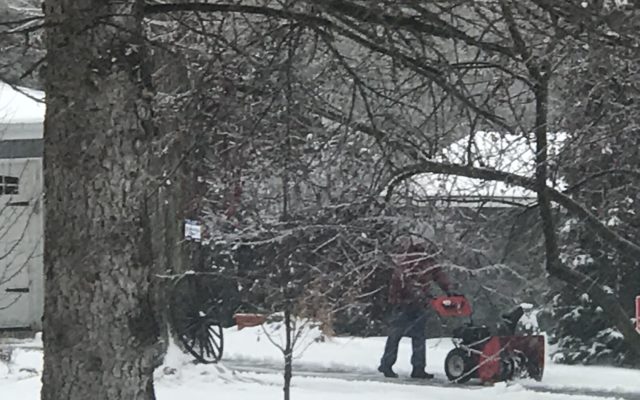WORK SMARTER NOT HARDER: Don’t Kill Yourself, Shoveling Snow

- Be heart conscious. If you have any kind of heart trouble, or have had any recent chest pain, hire someone or ask a friend or neighbor to help.
- Dress warmly. Mittens are warmer than gloves. Keep your ears and head covered – nose and mouth, too.
- Drink plenty of water. Before you start.
- Warm up, first.
- Pace yourself.
- Bend at the knees… Not your back (And toss the snow left, if you shovel right-handed, or vice-verse*).
- Push, don’t lift.
- Shovel while snow is fresh… It’s lighter. As it sits, it condenses.
- Here’s how to make it EASY (or, at least, a lot easier): If you’re shoveling snow to your right, point the shovel that way, with the handle in your left hand. If you want it to land to your left, put the handle in your right hand. The idea is to make it feel like you’re throwing it over your opposite shoulder, even if you’re just moving it a little. Smaller loads on the shovel actually make faster work of it.
Of course, hiring a plow or snow-blowing is easier than shoveling. 😉

Wayne L. Westcott, writes this, for the Patriot Ledger:
Don’t be the one who gets a heart attack, shoveling, this winter. And if you have had previous cardiovascular disease or lower back problems, you should avoid vigorous activity in cold temperatures, no matter what.
For most of us, however, these problems are preventable if we approach the task sensibly.
1. Dress appropriately for the weather. Don’t bundle up unless the temperatures are very low or the winds very strong. Snow shoveling is a calorie-consuming, heat-producing activity. Overheating (even in winter) is the body’s worst enemy. It places an extra burden on the circulatory system.
Keep the hands, toes and head warm, but don’t wear too many sweaters under your coat. It is better to be a little cool during the first 10 minutes than to be perspiring profusely during the last 30 minutes. Dress as though the temperature is 10 degrees warmer than it actually is because your body’s heat-producing mechanism will make up the difference.
2. Warm up before you step outside. The warm-up should also include stomach work such as trunk curls, since the midsection is the transition area between the legs and upper body. Take a few minutes to stretch, especially the muscles in the low back, the legs and the shoulder girdle. The warm-up also helps you to not feel quite so cold during the first few minutes.
3. Be a walker instead of a runner. Don’t rush into snow shoveling as though it were a road race. Start slow and stay slow. Enjoy the beauty of the hour, and stop frequently to inhale the fresh air. Treat snow shoveling as you would a walk around the neighborhood.
4. Use a small snow shovel. The major problem with snow shoveling is carrying too much weight (the snow) on an unfavorable lever system (the shovel). Snow is generally heavy, and the larger the shovel the more stress on the joint structures, particularly in your lower back area. Also, struggling to transport large quantities of snow at times forces isometric muscle contractions, which can elevate blood pressure beyond normal exercise levels. Small, slow and steady are key concepts.
5. Take frequent breaks and check your heart rate response. After 5 minutes of small, slow and steady shoveling take a break. During the break, straighten up, stretch to both sides, alternately pull each knee toward the chest and take a few deep breaths. More important, take your pulse (either on one side of the neck or at the wrist) to determine your heart rate. Count the beats for 15 seconds and multiply by four to determine your heart rate per minute. If your age is above 50, your heart rate should be below 120 beats per minute. If your heart rate is significantly higher than the recommended levels, you are working too hard. Slow down and take more frequent breaks. Your heart rate should parallel your feelings of physical exertion, which should be between 4 and 7 on a 1 to 10 scale of exercise effort.
6. Take serious steps to improve your physical fitness. People who live in cold climates can anticipate at least a few snowfalls every winter. The sensible approach to snow removal is a planned program of physical conditioning.
7. Don’t be a hero. Sometimes the snowplow presents a do-or-die situation with high-piled, hard-packed snow at the end of the driveway. Don’t insist on clearing the whole driveway by yourself. Get someone to help break up the big chunks deposited by the snowplow. Of course, there is always the alternative of a snowblower, but for most of us this is not a necessary expense.
Wayne L. Westcott, Ph.D., teaches exercise science at Quincy College and consults for the South Shore YMCA. He has written 25 books on physical fitness and strength training.
Check out the full article HERE.







